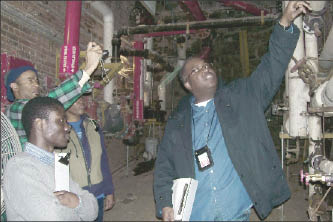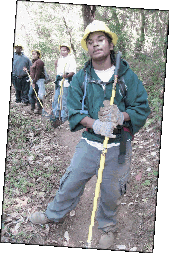 |
|
Pipeline to jobs: Groups like Solar One, which trains teens for “green” jobs, use internships to prepare disadvantaged youth for work and careers.
|
Since its founding in 2000, Year Up, a national job training curriculum for at-risk youth, has managed an enviable record of getting young people into jobs that offer a promising future. The organization, which has six U.S. sites, sees almost 90 percent of its graduates receive full or part-time job placements within four months of completing their internships. The average starting wage: $15 an hour.
While the idea of helping at-risk older youth get a leg up on the future by giving them on-the-job training sounds great, implementing it is something else. Surprisingly few organizations undertake the training of these young people for long-term careers or put them in internships that expose them to real-world job situations and income-earning opportunities.
Kweku Forstall, executive director of Year Up Atlanta, says perspective has a lot to do with success. “Year Up is not designed to be a charitable endeavor,” he says. “We’re about job training.” Forstall says the key to Year Up’s success has been the organization’s high standards: “You’ve got to set the bar high. Hold youth accountable. Teach them consequences. And provide mentoring and support to boost self confidence.”
Finding Partners: Central to Year Up’s success – and that of other similar programs – has been its ability to establish relationships with corporations and agencies willing to provide internships to its trainees. Forstall says Year Up screens all its program participants, eliminating the cost of background checks and drug screening for employers, and provides the employers with well-trained interns who know how to behave in a business environment.
What Works: Programs that offer wages or a stipend create demand. Allan Johnson, director of youth services for JobTrain in Menlo Park, Calif., says he has more applicants than internships because the program offers money, as well as training and job placement help. “We’re putting money in their pockets in an honest way,” he says.
Internships that train young people for jobs that will be in demand, particularly in this tight economy, are best. Michael Johnson-Chase says the interns from Solar One are well-positioned once they leave the Green Jobs Training Program. Year Up, in Atlanta, has a similar approach, training people exclusively for entry-level information technology jobs, which are always in demand. “Entry-level IT is a high turnover sector,” says Forstall. “When we talk to partners, we frame it as a business proposition. There is always a need for entry-level IT workers, and our students come out of our program turnkey.”
Lory Newmyer, executive director of the Hull Lifesaving Museum in Boston, says its Maritime Apprentice Program (MAP) for incarcerated youth has special advantages: “The Hull Lifesaving Museum is a small and flexible organization. We are able to serve kids until there is a positive outcome.”
“By the time kids leave MAP, they will have a network of caring adults behind them,” Newmyer says. “They will have lived and worked outside the criminal justice system and will have worked in an internship with an industry partner.”
The Challenges: Money is hard to find right now for most nonprofits, and internship programs for at-risk youth are no exception. Johnson-Chase says Solar One faces extra challenges because it’s pushing internships in green jobs, something he says private foundations haven’t yet recognized the need for. “We’re waiting for funders to catch up,” he says.
These four organizations are not just turning out youth with resumes but youths with jobs.
Year Up Atlanta
Atlanta
(404) 249-0300
http://www.yearup.org/locations/ atlanta.htm
The Strategy: Train at-risk young adults in information technology skills, and hook them up with internships at local companies.
Getting Started: Atlanta is the sixth U.S. city to implement the Year Up program, which was started in Boston nine years ago by entrepreneur Gerald Chertavian. “We’re part of a successful model looking to expand nationally,” says the Atlanta program’s executive director, Kweku Forstall.
How it Works: Youth participating in Year Up receive six months of training in IT skills on site in preparation for a six-month internship with a local company’s IT department. In addition to learning the skills they will need to work in entry-level IT jobs, the youths also learn business skills like problem solving, working on a team, and taking the initiative in the workplace.
Youth Served: Year Up Atlanta recruited its first class in March and has 24 students participating. Forstall says Year Up will expand the program each year, until it is serving 300 youths annually. Participants must be between 18 and 24 and hold a high school diploma or GED. All have issues that have put them at risk, such as former incarceration for misdemeanors or homelessness. Once they begin their internships, students receive a $200 stipend weekly.
Staff: Year Up Atlanta has six full-time staff members, all of whom are trained to serve youth in advisory roles.
Money: Year Up Atlanta operates on an annual budget of $1.2 million. Some start-up capital was provided by Year Up headquarters, but most came from a group of Harvard Business School graduates in Atlanta, who each gave $100,000 to support the program. In the future, Forstall expects the program to be funded largely by the fees of $795 per week per student that local companies pay for the interns. Students receive a quarter of that stipend, while the rest goes to Year Up.
Results: Year Up Atlanta’s first class won’t graduate until next spring, but nationally, 86 percent of graduates obtain full or part-time employment after their internships.
Green Jobs Training Program
Solar One
New York
(212) 505-6050
http://www.solar1.org
The Strategy: Train at-risk youth in the principles and techniques of sustainable building and renovation to give them front-line access to the nation’s growing pool of green jobs.
Getting Started: The Green Jobs Training Program of Solar One ran its pilot program last year in cooperation with the alternative Manhattan Comprehensive Night and Day High School, which is for nontraditional students who often have full-time jobs, yet fall below the poverty line. The program has expanded to partner with Workforce Career Centers, operated by the New York City Workforce Investment Board.
How it Works: Partner high schools and workforce agencies provide Solar One with recruits who participate in training courses in one of five green job fields – building performance, photovoltaic installation and advocacy, deconstruction and materials recycling, green entrepreneurship, and horticulture, landscape, and park maintenance. Students participate in one to several weeks of training and interning on site at CEC. Once training is complete, workforce agencies find placements for the students. During training, youths receive a weekly stipend of $35, plus a MetroCard, for transportation.
Youth Served: Michael Johnson-Chase, who works with Green Collar Jobs Development at Solar One, says he anticipates the Green Jobs Training Program will serve approximately 300 youths by the end of this year. Program participants typically range in age from 18 to 24 and are defined as “at-risk” by the various schools and agencies that refer them.
Staff: The Green Jobs Training Program employs five staff members and one subcontractor on an as-needed basis.
Money: Overall budget numbers are not available. Johnson-Chase says Solar One can train about 20 youths at a cost of $7,500 per week. Solar One receives some funding for its Green Jobs Training Program from Con Edison and also supports itself through contracts with area workforce centers. Johnson-Chase said he hopes to obtain some federal stimulus money later this year through New York City’s Department of Youth and Community Development.
Results: There is no data yet on interns’ job placements or retention.
Maritime Apprentice Program
Hull Lifesaving Museum
Boston
(617) 443-1900
http://www.lifesavingmuseum.org
The Strategy: Prepare youths in the custody of the Massachusetts Department of Youth Services for jobs in the maritime industry by providing internships of two years or longer in the seaport boat shop of the Hull Lifesaving Museum.
 |
|
Bright futures beckon for youths who learn to work on boats at Hull Lifesaving Museum.
Photo: Beth Howard |
Getting Started: The Hull Lifesaving Museum’s Maritime Apprentice Program (MAP) began as a summer internship program in the 1980s as part of the museum’s mission to “save” people in the present. MAP expanded into a year-round program in 2005.
How It Works: DYS refers incarcerated youths preparing for re-entry into society to MAP to obtain on-the-job training in the maritime industry. MAP case workers visit the youths in prison and spend about two months evaluating them before taking them on board. Once enrolled in MAP, the youths serve a two-year minimum internship with the museum’s seaport boat shop, where they learn boat building and repair through work on the museum’s 14 craft. During this time, the young people also are required to be working on a high school equivalency degree, if they don’t already have one, and are paid a weekly stipend of $100 to $150. Once they have proved themselves reliable – sometimes as soon as six weeks – they are often apprenticed to maritime industry partners in Boston, but they remain under MAP’s supervision and its training program.
Youth Served: MAP serves about 20 youths a year, most of them male, from 17 to 23 years old. Most are high school dropouts and serious offenders. Some come with mental health problems and learning disabilities. About 30 percent are parents of young children. Half of the program participants are African-American, and 35 percent are Latino.
Staff: MAP has three full-time and four part-time staff members.
Money: MAP’s annual budget is $418,000. Funding comes from DYS, the Department of Workforce Development (through Workforce Investment Act funding from the U.S. Department of Labor), and more than a dozen local private foundations.
Results: The year-round program is in its fourth year and, to date, 69 percent of its participants have not reoffended, and 84 percent are gainfully employed or enrolled in advanced training at a college or vocational school.
JobTrain
Menlo Park, Calif.
(650) 330-6429
http://www.jobtrainworks.org
The Strategy: Train low-income, at-risk youth on the job for employment in a variety of area industries, and assist them with job placement once their internships are complete.
 |
| Photo: JobTrain |
Getting Started: JobTrain has been in operation since 1965 (previously known as Opportunities Industrialization Center West), offering training and job placement assistance to adults facing barriers of education, previous incarceration, homelessness and drug abuse. Two decades ago, the nonprofit started a Youth Services division, and five years ago, it began working to build a youth internship program.
How It Works: JobTrain has existing relationships with employers in East Palo Alto and surrounding areas and uses those relationships to connect at-risk youth with internship opportunities in fields including hospitality, landscaping, mechanics and web design. Young people, most of whom have already had training on-site at JobTrain through the agency’s after-school and out-of-school programs, get on-the-job training for four to 12 weeks. Youths are paid $8 to $10 an hour, depending on their experience and education levels.
 |
|
Getting area employers on board is the key for JobTrain, where youths work in such diverse areas as food preparation and landscaping.
Photo: JobTrain |
Youth Served: The program serves 175 youths a year, ages 14 to 24, mostly minority youths facing economic and social barriers. Half of the youth interns are either on probation or have young children of their own, and 60 percent have dropped out of school. Most of the youths apply to JobTrain voluntarily, and there are seven to eight applicants for every internship opportunity.
Staff: Two staff members work directly with the youth internship program, although they also have duties in other areas of JobTrain.
Money: The budget is $350,000 to $400,000 a year. The youth internship program started with a grant from the William and Flora Hewlett Foundation. Other partners and funders include Canopy, http://EPA.net, Sequoia Union High School, One East Palo Alto and El Concilio of San Mateo County.
Results: JobTrain Director of Youth Services Allan Johnson says an indication of the youth internship program’s success is that students want to repeat it, although JobTrain limits the number of alumni interns to 25 percent of the total. Ninety percent of interns complete their training.





























